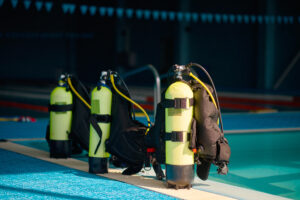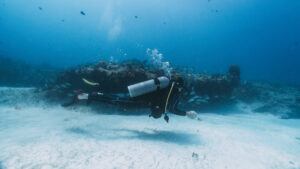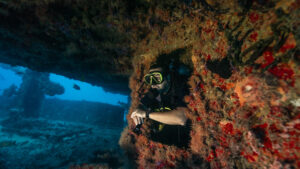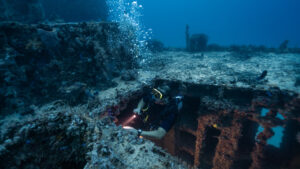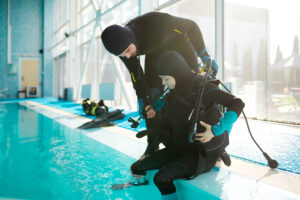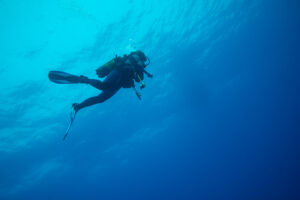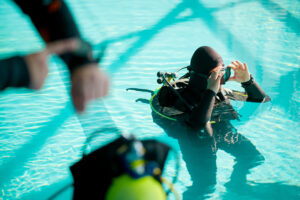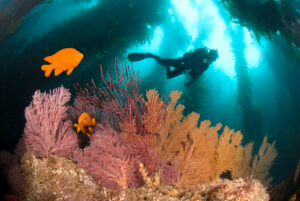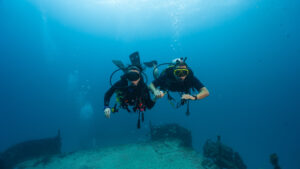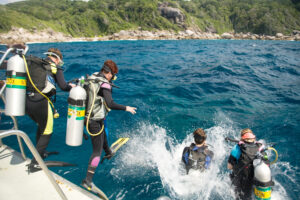What is a Dive Flag?
A dive flag is a crucial piece of safety equipment used in scuba diving to signal the presence of divers in the water to nearby boats and other watercraft. It is typically a brightly colored flag that can be easily seen from a distance, usually featuring a red background with a white diagonal stripe or a blue-and-white Alpha flag. The primary purpose of the dive flag is to prevent accidents by informing others in the vicinity that divers are below the surface, thus promoting safe diving practices and reducing the risk of injury or fatality. Understanding the use and significance of the dive flag is essential for both divers and boaters to ensure a safe and enjoyable experience in the water.
History of the Dive Flag
The concept of the dive flag has a rich history that dates back several decades. The red-and-white dive flag, which is widely recognized today, was first introduced in the early 1950s by Denzel James Dockery. Dockery, a diver from Michigan, sought to create a universal symbol that would alert boaters to the presence of divers underwater. His initial design was a red flag with a white diagonal stripe, which quickly gained acceptance within the diving community. This design was inspired by the International Code of Signals, particularly the semaphore signal for the letter “A,” indicating “I have a diver down; keep well clear at slow speed.”
The dive flag’s adoption was further solidified when it was endorsed by various diving organizations and incorporated into state laws across the United States. In 1956, the state of Michigan became the first to mandate the use of dive flags, setting a precedent that would be followed by other states and countries. Over time, the use of the dive flag spread globally, with many countries establishing their own regulations to ensure diver safety.
In addition to the red-and-white flag, the blue-and-white Alpha flag, which is part of the International Code of Signals, also came into use. The Alpha flag is predominantly used in international waters and indicates that the vessel is engaged in diving operations and has limited maneuverability. The dual existence of these flags underscores the importance of clear and recognizable signals to safeguard divers worldwide.
Types of Dive Flags
There are two main types of dive flags used to signal the presence of divers in the water: the traditional red flag with a white diagonal stripe and the blue-and-white Alpha flag. Each flag has specific features and is used in different contexts, making them both essential tools for ensuring diver safety.
The red flag with a white diagonal stripe is perhaps the most recognized dive flag. This flag is rectangular, with the white stripe running diagonally from the upper left corner to the lower right corner. It is predominantly used in the United States and many other countries to indicate that divers are underwater and that boats should keep a safe distance and reduce speed. The red-and-white dive flag is often attached to a buoy or float, which is then anchored to the dive site, ensuring it remains visible above the water’s surface.
The blue-and-white Alpha flag, on the other hand, is part of the International Code of Signals and is used primarily in international waters. The Alpha flag is blue with a white hoist and a swallowtail design, resembling the letter “A” in the semaphore alphabet. This flag is flown from the vessel conducting the dive operations, indicating that the vessel is restricted in its ability to maneuver due to diving activities. The Alpha flag is crucial in ensuring that other vessels in the vicinity recognize the potential hazards and navigate accordingly.
Geographical variations in the use of these flags exist, with some regions adopting one flag more commonly than the other. In the United States and Canada, the red-and-white dive flag is widely used, while in Europe and other parts of the world, the Alpha flag may be more prevalent. Regardless of the type, both flags serve the essential function of promoting diver safety by alerting others to the presence of divers in the water.
Legal Requirements
International laws and regulations governing the use of dive flags are essential in maintaining diver safety across different jurisdictions. Various countries have implemented specific legal requirements to ensure that dive flags are used correctly and consistently, thereby minimizing the risk of accidents.
In the United States, the use of the dive flag is regulated at both the federal and state levels. Most states mandate the display of the red-and-white dive flag whenever divers are in the water. For instance, in Florida, state law requires that the flag be at least 50.8 cm by 50.8 cm (20 inches by 20 inches) in size and flown from a buoy or boat. Divers must stay within a certain distance of the flag, typically within 91 meters (100 yards), and boats are required to maintain a safe distance from the flag, usually around 91 meters (100 yards) or more. Failure to comply with these regulations can result in fines and other penalties.
In Europe, the Alpha flag is more commonly used, and its use is often regulated by maritime authorities. For example, in the United Kingdom, the Merchant Shipping (Diving Safety) Regulations require vessels engaged in diving operations to display the Alpha flag. Similar regulations exist in other European countries, ensuring a standardized approach to signaling diving activities.
Australia also has specific laws governing the use of dive flags. The Australian Maritime Safety Authority mandates that the Alpha flag be displayed on vessels conducting diving operations. Additionally, divers are required to use a surface marker buoy with the red-and-white dive flag when diving from shore or in areas with boat traffic.
The consequences of not displaying a dive flag while diving can be severe. Divers risk not only their own safety but also the safety of others in the vicinity. Boaters who are unaware of the presence of divers are more likely to inadvertently come too close, increasing the likelihood of accidents. In many jurisdictions, failure to use a dive flag as required by law can result in fines, legal liability, and, in extreme cases, criminal charges if an accident occurs.
Dive Flag Usage
Proper usage of dive flags is essential to ensure they effectively signal the presence of divers and promote safety. Understanding how to correctly display and position dive flags is crucial for both divers and boaters.
When diving from a boat, the dive flag should be prominently displayed on the vessel, ideally at the highest point where it is most visible from all directions. This ensures that other boaters can easily see the flag and take appropriate action to avoid the area. The flag should be large enough to be seen from a distance, typically at least 50.8 cm by 50.8 cm (20 inches by 20 inches) for the red-and-white dive flag. The Alpha flag should also be of a size that makes it easily recognizable.
For shore dives, the dive flag is usually attached to a buoy or float anchored near the dive site. Divers should remain within a specified distance of the flag, commonly within 91 meters (100 yards), to ensure their safety and the effectiveness of the signal. It is also important to regularly check the flag’s position and ensure it remains upright and visible throughout the dive.
In different water environments, the placement of the dive flag may vary. In open water with minimal boat traffic, a single flag attached to the dive boat may suffice. However, in areas with heavy boat traffic or near popular tourist spots, additional measures may be necessary. For instance, deploying multiple flags or using additional markers to highlight the dive area can enhance visibility and safety.
Common mistakes and misconceptions about dive flag placement can undermine their effectiveness. One common error is positioning the flag too low on the boat or buoy, reducing its visibility. Another mistake is failing to replace damaged or faded flags, which can be difficult to see. Additionally, some divers neglect to stay within the designated distance from the flag, diminishing the signal’s reliability and potentially putting themselves at risk.
Safety Implications
The role of dive flags in preventing diving accidents cannot be overstated. These flags serve as a crucial communication tool, alerting boaters to the presence of divers below the surface and prompting them to exercise caution.
Statistical data and research findings consistently highlight the effectiveness of dive flags in enhancing diver safety. Studies have shown that areas with strict dive flag regulations and high compliance rates tend to have lower incidences of diving-related accidents. For example, data from the Florida Fish and Wildlife Conservation Commission indicate that the use of dive flags has significantly reduced the number of boat-diver collisions in the state. By making divers more visible to boaters, dive flags help prevent accidents and save lives.
Several real-world stories illustrate the importance of dive flags in maintaining diver safety. In one instance, a group of divers in the Gulf of Mexico credited their dive flag with averting a potentially fatal accident. A speedboat approached their dive site at high speed, but upon seeing the dive flag, the boat operator immediately slowed down and altered course, avoiding a collision. Such incidents underscore the dive flag’s role in facilitating communication between divers and boaters, allowing for safer navigation and reducing the risk of accidents.
Moreover, dive flags contribute to a culture of safety and awareness within the diving community. By adhering to regulations and best practices for using dive flags, divers demonstrate their commitment to safety and encourage others to do the same. This collective responsibility helps create a safer environment for everyone involved in water activities.
Key Takeaways
The dive flag is an indispensable safety tool in scuba diving, serving as a critical signal to alert boaters and other watercraft to the presence of divers below the surface. Understanding the history, types, legal requirements, proper usage, and safety implications of dive flags is essential for promoting safe diving practices and preventing accidents. By adhering to these guidelines and regulations, divers and boaters can work together to ensure a safe and enjoyable experience in the water.


